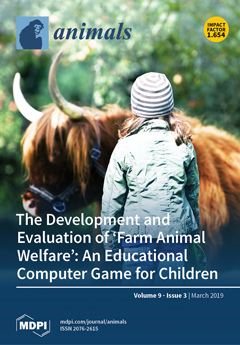For the study, forty lambs were weighed and assigned into two treatments to determine the effects of feeding garlic powder on growth performance, rumen fermentation, and the health status of lambs infected with gastrointestinal nematodes (GINs). The lambs were fed with a basal diet without or with 50 g/kg garlic powder for 84 d. Data were analyzed by a general linear or mixed model of SAS software and differences were considered statistically significant if
p ≤ 0.05. Results showed that garlic powder supplementation increased the lambs’ average daily gain (
p = 0.025), digestibility of dry matter (
p = 0.019), and crude protein (
p = 0.007). No significant changes were observed on the dry matter intake, feed conversion ratio, as well as the apparent digestibility of lipid and fiber. An interactive effect between treatment and feeding day was observed on ruminal pH (
p < 0.001) and ammonia nitrogen concentration (
p < 0.001). Ruminal pH (
p < 0.001) and ammonia nitrogen concentration (
p < 0.001) decreased with garlic powder supplementation, while ammonia nitrogen concentration increased (
p = 0.001) with the extension of the feeding period. Garlic powder supplementation increased the total volatile fatty acid concentration (
p < 0.001) in the rumen fluid, the molar proportion of acetic acid (
p = 0.002), propionic acid (
p < 0.001), and isovaleric acid (
p = 0.049), but it decreased the ratio of acetic acid to propionic acid (
p = 0.015). The lambs’ fecal egg count decreased (
p < 0.001), but the packed cell volume and body condition scores of lambs increased (
p < 0.001) with garlic powder supplementation. In conclusion, feeding garlic powder increased growth performance, feed digestion, rumen fermentation, and the health status of lambs infected with GINs.
Full article






